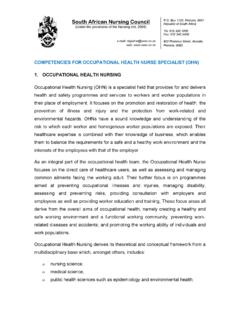Transcription of Epilepsy Scotland Occupational Health Guide Epilepsy and ...
1 Epilepsy Scotland Occupational Health GuideEpilepsy and Occupational HealthHelp with things like RISK ASSESSMENT and EQUALITY positive work experience for people with Epilepsy *info on Epilepsy and the workplaceD190 ES Occupational Health 115/2/11 11:48:08 Contents Introduction Page 3 The links between work and Health and how employers can benefit from using this Guide . Section 1 About Epilepsy Page 6 Key facts about what Epilepsy is and how seizures can affect people. Section 2 Equality and confidentiality Page 8 Essential information on equality legislation, Epilepsy and reasonable adjustments and how to handle Epilepsy disclosure in the workplace. Section 3 Your risk assessment Page 11 Why customised risk assessments for employees with Epilepsy are important, what is involved and what to do with the outcomes. Information on Epilepsy and specific concerns such as shift work, medication, working with VDUs and working around hazards.
2 Section 4 Occupational Health Page 15 An explanation of Occupational Health , guidance on communicating with Occupational Health Professionals to get the best outcome, and dealing with employee concerns about the Occupational Health process. Section 5 Good practice measures Page 18 Good practice measures concerning communication, sick leave and Epilepsy awareness to enable employers and employees to maintain a positive relationship. Information on Epilepsy and emotional wellbeing and Epilepsy first aid in the workplace. Section 6 Ill- Health , retirement and Epilepsy Page 20 Key information about Epilepsy and ill- Health retirement. Section 7 Useful resources Page 25 First aid for tonic-clonic seizures, how to refer an employee for Occupational Health assessment and sources of further information and ES Occupational Health 215/2/11 11:48:08 INTRODUCTIONCONTRIBUTORSFrom the Chief ExecutiveLesslie Young, Chief Executive, Epilepsy ScotlandMorag Clark, Clinical Occupational Health Manager Strathclyde PoliceDr Katharine Cryer, Consultant Occupational Health Physician, Serco Occupational HealthDr Robert Sharpe, Consultant Chartered PsychologistDr Frederick G Taylor, Senior Consultant Occupational Physician, Bcerta Occupational Health , GlasgowAnissa Tonberg, Policy & Development Manager, Epilepsy ScotlandDr Freddie Westbrook, Consultant Occupational Physician, Serco Occupational HealthChristine Whiteside, HR and Office Manager, Epilepsy ScotlandLesslie Young, Chief Executive, Epilepsy ScotlandFeeling valued, having a purpose in life and a reason to get up every morning is important for everyone.
3 Consistent employment helps to achieve all of these aims. For anyone who is living with Epilepsy and trying to gain employment, the challenges in their daily life combined with those encountered or anticipated in the work place may seem insurmountable. Equally, for someone already in work who is newly diagnosed with the condition there may be anxiety about how they will maintain their employment. It was through the many calls to Epilepsy Scotland s Helpline from people in these situations, concerned about work and career, that I saw the need for more and better information about Epilepsy in the workplace. This Guide is aimed at employers, but will be helpful to both employers and employees in addressing the complex relationship that exists between Epilepsy and employment. Many people who have Epilepsy enjoy a fulfilling worklife. On the occasions when the condition causes difficulties this robust document offers information and advice from experts in the fields of Occupational Health medicine and Epilepsy .
4 It will assist employers and employees alike to ensure the best possible outcome for people with Epilepsy in the workplace. It will get the job Scotland Occupational Health Guide3D190 ES Occupational Health 315/2/11 11:48:08 Work and good healthDr Freddie Westbrook, Consultant Occupational Physician, Serco Occupational HealthThere is an increasing recognition of the important positive relationship between being in work and good Health . It is now accepted that this applies both to those with and without disabilities. Getting into and staying in the right type of work plays an important part in how we see ourselves and also how others see us. A positive work experience can lead to improved emotional function through increased self esteem and self fulfilment. Physical function can also improve by remaining active. Over recent years there has been a profound shift in how we consider the link between work and Health .
5 In particular, people with disabilities and Health problems are encouraged to show their productivity, creativity and add organisational value. However evidence suggests that this situation varies widely across the country. Individuals with Epilepsy are known to have a much lower level of employment than average in the UK, resulting in a lack of further opportunity for develpment. Additionally, low self esteem arising from not working can compound their reduced chances of gaining and remaining in long term face many challenges in an ever-shifting economic environment. They may be concerned about the impact of employing people with disabilities. This booklet sets out a framework which aims to support employers in employing people with framework which aims to support employers in employing people with Scotland Occupational Health Guide 1 Black, C - Working for a healthier tomorrow , London, 2008 Epilepsy Scotland Occupational Health Guide4D190 ES Occupational Health 415/2/11 11:48:08 Why use this good practice Guide ?
6 Epilepsy is one of the world s most common neurological conditions. It affects one in every 130 people and there are currently an estimated 241,692 people of working age with Epilepsy in the UK. It is likely you may interview and employ a person with Epilepsy at some point, or you may already be doing so. 40,000 people in Scotland have Epilepsy and a further eight people a day are diagnosed with the condition. The diagnosis of Epilepsy is steadily on the increase. As it rises, so will the number of people with Epilepsy in the workplace. The majority of people with Epilepsy will have as many skills and competencies as those who do not, so their condition should not be a barrier to most forms of employment. An employee may disclose they have Epilepsy during the recruitment process, or develop it while employed by your organisation. As an employer, it is important not to make assumptions about someone s Epilepsy - there are over forty types of seizure and Epilepsy syndromes and everybody s condition is different.
7 In a minority of people, seizures may happen at work or work performance may be affected by anti- Epilepsy drugs (AEDs). Gathering accurate information on the person s seizures and looking closely at the nature of their job will help in deciding the best way forward with each individual. Occupational Health professionals are trained to look at medical evidence and assess risk. If necessary, they can also suggest the reasonable adjustments that may be required to help your employee maintain a productive working good practice Guide is designed to tell you in plain terms what you need to know about Epilepsy and the workplace and to help employers and employees get the most out of Occupational Health services. It also makes clear the legal responsibilities of employers according to anti-discrimination and Health and Safety at Work legislation. It includes a checklist to use when referring someone to an Occupational Health service, and details of where to get further support.
8 Many people with Epilepsy will require no additional support or adjustments in the workplace, but others will require some changes to do their job. By following good practice guidelines, employers can feel more confident in making reasonable adjustments, where necessary, to accommodate people with this condition. In short, using good practice towards people with Epilepsy can help your organisation to benefit most from their Office for National Statistics labour market statistics September 2010; includes employed and unemployed, excludes inactive (eg. Retired, looking after family or claiming incapacity benefit) Epilepsy Scotland Occupational Health Guide5D190 ES Occupational Health 515/2/11 11:48:08 About epilepsySECTION 1 What is Epilepsy ?People can have an isolated seizure without having Epilepsy . This could be for reasons like a high temperature or a head injury. People with Epilepsy have a tendency to have repeated seizures and the majority are able to stay seizure-free with the right medication.
9 Billions of brain cells pass messages to each other to control what we say and do. The brain uses electrical activity to pass these messages on. If there is too much electrical activity, messages can get mixed up and cause seizures. Seizures usually last a short time and the brain works normally between them. Some people find their seizures are triggered by certain things, such as not getting enough sleep or skipping meals. Epilepsy can affect people in different ways. There are over 40 types of seizure and Epilepsy syndromes, and people may experience more than one kind. Some people with Epilepsy may only experience seizures while they are awake and fully aware. This might mean the seizure takes the form of an unusual taste or smell. Some people with Epilepsy may have seizures where they jerk, fall down and lose consciousness. Others may only have seizures when they are asleep.
10 Up to 70% of people with Epilepsy have no seizures while taking medication. Therefore, the suitability of a job for a person with Epilepsy will depend on the nature of the job and how seizures affect , there are still a number of myths about Epilepsy . Epilepsy is a physical condition. It is not contagious. People with Epilepsy can lead a full and rewarding life. If you would like to find out more about Epilepsy and how it can affect people please get in touch with Epilepsy Scotland s freephone helpline on 0808 800 2200 or go to Scotland Occupational Health GuideD190 ES Occupational Health 615/2/11 11:48:08 About seizuresOur brain controls all our speech, movement, emotions, memory, vision, hearing and much more. Different parts of the brain control different things. What happens during a seizure depends on which area of the brain is involved and what it controls. Seizures can be generalised or partial.









